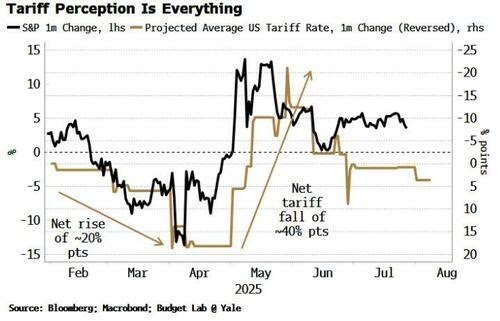Tariffs are becoming permanent tools of U.S. foreign policy, with firms like Apple and Boeing caught in the crossfire.
Sectors & Industries
Table of Contents
The world isn’t re-globalizing—it’s re-aligning. As artificial intelligence accelerates corporate automation, governments are reshaping the rules of trade to reflect geopolitical loyalties, not economic efficiency. Tariffs, once seen as market-disrupting shocks, are now embedded features of the global economy—and markets have stopped flinching.

Despite a steady rise in effective tariff rates this year, the S&P 500 has barely blinked. At the start of 2025, stocks reacted sharply to projected tariff hikes. But by July, that relationship collapsed. When tariff projections fell 40 points in May and June, equities rallied—even though the actual tariff load remained high. The takeaway? Investors now care more about avoiding worst-case scenarios than about the cumulative cost. Short-term relief, not structural impact, is what moves markets.
That dynamic was on full display with President Trump’s late-July trade deal with the EU. Days before a planned 30–50% tariff wall was set to trigger, the two sides agreed to a 15% baseline on most goods. Steel and aluminum tariffs remain at 50%, but Europe pledged over $750B in U.S. energy purchases (including nuclear reactors/ OKLO jumped on the news) and a wide-ranging commitment to American military equipment—turning trade into a security alliance. Whether those numbers are real or symbolic doesn’t seem to matter to markets right now.
Meanwhile, the U.S. and China extended their tariff freeze for another 90 days. The Stockholm meetings may yield little substance, but the extension itself delays escalation. For investors, another short-term win.
The picture is less stable elsewhere. India and Russia remain outside Trump’s new trade framework and now face 25% tariffs starting August 1. On Truth Social, Trump called India a “dead economy” and accused officials of rigging jobs data to hurt his campaign. Delhi responded with defiance and no sign of compromise. Analysts warn of a $10 billion export hit and rising strain on U.S.–India ties, once seen as a counterweight to China.
U.S. firms with major India exposure—Apple, GE, Dell, Cisco, and Boeing—now face potential disruption. Apple produces over 7% of iPhones in India, while Boeing relies on Indian-made components. Tech leaders like Microsoft, Amazon, and Google operate large R&D and support hubs in the country.
In parallel, Trump has threatened a 10% surcharge on BRICS nations pursuing de-dollarization, signaling a broader trade fragmentation. With each new deal or penalty, the message becomes clearer: access to the U.S. market now depends on strategic alignment—military, monetary, and energy-based.
Join LevelFields now to be the first to know about events that affect stock prices and uncover unique investment opportunities. Choose from events, view price reactions, and set event alerts with our AI-powered platform. Don't miss out on daily opportunities from 6,300 companies monitored 24/7. Act on facts, not opinions, and let LevelFields help you become a better trader.

AI scans for events proven to impact stock prices, so you don't have to.
LEARN MORE